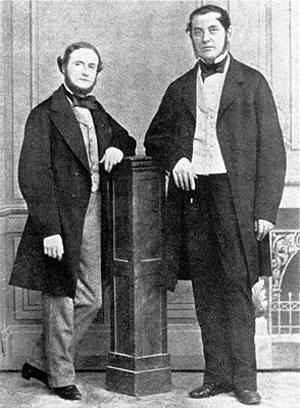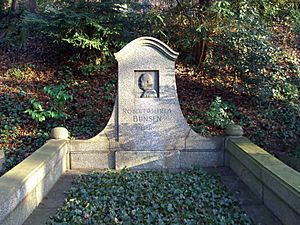Robert Bunsen facts for kids
Quick facts for kids
Robert Bunsen
|
|
|---|---|
| Born |
Robert Wilhelm Eberhard Bunsen
30 March 1811 Göttingen, Westphalia, Rhine Confederation
|
| Died | 16 August 1899 (aged 88) |
| Alma mater | University of Göttingen |
| Known for |
|
| Awards |
|
| Scientific career | |
| Fields |
|
| Institutions |
|
| Doctoral advisor | Friedrich Stromeyer |
| Doctoral students |
|
| Other notable students | |
Robert Wilhelm Eberhard Bunsen (born March 30, 1811 – died August 16, 1899) was a famous German chemist. He studied the light given off by heated elements. With physicist Gustav Kirchhoff, he discovered two new elements: caesium in 1860 and rubidium in 1861. The Bunsen–Kirchhoff Award for spectroscopy (studying light) is named after them.
Bunsen also created ways to analyze gases. He was a pioneer in photochemistry, which is the study of how light causes chemical reactions. He also worked with chemicals containing arsenic. With his lab helper Peter Desaga, he made a much better lab burner. This burner is now simply called the "Bunsen burner" and is used in labs all over the world.
Contents
Robert Bunsen's Early Life and Education
Robert Bunsen was born in Göttingen, Germany, in 1811. This area is now part of Lower Saxony. He was the youngest of four sons. His father, Christian Bunsen, was a professor at the University of Göttingen.
After attending school in Holzminden, Bunsen started studying at Göttingen University in 1828. He focused on chemistry with Friedrich Stromeyer. He also studied mineralogy (the study of minerals) and mathematics. After getting his PhD in 1831, Bunsen traveled around France, Germany, and Austria for two years. During his travels, he met other important scientists like Justus Liebig.
Bunsen's Amazing Career and Discoveries
In 1833, Bunsen became a lecturer at Göttingen. He started studying how metal salts of arsenous acid dissolve. He found that a substance called iron oxide hydrate could be used to remove arsenic. This discovery led to the best way to treat arsenic poisoning even today.
In 1836, Bunsen became a professor at the Polytechnic School of Kassel. After three years, he moved to the University of Marburg. There, he continued his work on cacodyl compounds, which are very dangerous. He became a full professor in 1841. In 1846, Bunsen even joined an expedition to study volcanoes in Iceland!
Bunsen's work became famous quickly. This was partly because cacodyl is extremely poisonous and catches fire in the air, making it very hard to work with. Bunsen himself almost died from arsenic poisoning. An explosion with cacodyl even caused him to lose sight in his right eye.
In 1841, Bunsen invented the Bunsen cell battery. This battery used a carbon electrode instead of expensive platinum. In 1851, he became a professor at the University of Wrocław.

In 1852, Bunsen moved to the University of Heidelberg. There, he used electrolysis (using electricity to separate chemicals) to make pure metals. These included chromium, magnesium, aluminium, manganese, sodium, barium, calcium, and lithium.
He started working with Henry Enfield Roscoe in 1852. They studied how hydrogen chloride (HCl) forms from hydrogen and chlorine when exposed to light. Their work led to the reciprocity law of Bunsen and Roscoe, which is important in photography.
Bunsen stopped working with Roscoe in 1859. He then teamed up with Gustav Kirchhoff to study the light given off by heated elements. This field is called spectrum analysis. For this research, Bunsen and his assistant, Peter Desaga, improved a special gas burner by 1855. This new design created a very hot and clean flame. It is now known as the "Bunsen burner".
People had studied the colors of heated elements before, but not in a detailed way. In 1859, Kirchhoff suggested using a prism to split these colors into a spectrum. By October, they had invented a special tool called a spectroscope. With it, they could identify the unique light patterns of sodium, lithium, and potassium.
Bunsen worked hard to purify samples. He proved that very pure samples always gave unique light patterns. While doing this, he found new blue light lines in samples of mineral water from Dürkheim. He thought these lines meant there was a new, undiscovered element. After carefully distilling 40 tons of this water, he managed to get 17 grams of a new element in 1860. He named it "caesium," from the Latin word for deep blue. The next year, he discovered rubidium using a similar method.
In 1860, Bunsen was chosen as a foreign member of the Royal Swedish Academy of Sciences. He also became a member of the American Philosophical Society in 1862.
In 1877, Robert Bunsen and Gustav Kirchhoff were the first to receive the important Davy Medal. They earned it for their research and discoveries in spectrum analysis.
Bunsen's Personality and Life
Bunsen was one of the most respected scientists of his time. He was an excellent teacher who cared deeply about his students, and they admired him just as much. Even when scientists had strong arguments, Bunsen always acted like a true gentleman. He preferred to work quietly in his lab, making useful discoveries. He never patented any of his inventions, as a matter of principle. He also never married.
Despite being humble, Bunsen was a fun and interesting person. He had a great sense of humor, and many funny stories are told about him.
Retirement and Passing
When Bunsen retired in 1889 at the age of 78, he focused entirely on geology and mineralogy. These were interests he had enjoyed throughout his life. He passed away in Heidelberg, Germany, on August 16, 1899, at the age of 88.
See also
 In Spanish: Robert Bunsen para niños
In Spanish: Robert Bunsen para niños


